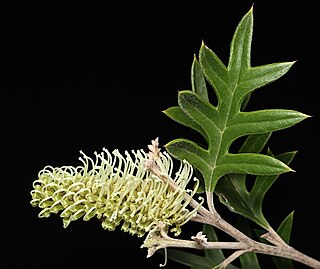
Alternation of generations is the predominant type of life cycle in plants and algae. In plants both phases are multicellular: the haploid sexual phase – the gametophyte – alternates with a diploid asexual phase – the sporophyte.

Cryptocoryne is a genus of aquatic plants from the family Araceae. The genus is naturally distributed in tropical regions of India, Southeast Asia and New Guinea.

Anubias is a genus of aquatic and semi-aquatic flowering plants in the family Araceae, native to tropical central and western Africa. They primarily grow in rivers and streams, but can also be found in marshes. They are characterized by broad, thick, dark leaves that come in many different forms. The genus was revised in 1979 and since then its nomenclature has been stable. Species can be determined by using mostly characteristics of the inflorescence. Because of the often shady places where the plants grow, the genus was named after the Egyptian god Anubis, the god of the afterlife. The genus was first described in 1857 by Heinrich Wilhelm Schott, with A. afzelii as its type species.

Echinodorus berteroi is an aquatic plant species in the Alismataceae It is native to the southern and central parts of the United States, as well as Central America, the West Indies, and South America as far south as Argentina.

Barclaya is a genus of six species of flowering plants of the family Nymphaeaceae. Barclaya are aquatic plants native to tropical Asia. The genus was named in honour of the American-born English brewer and patron of science Robert Barclay.

Cryptocoryne beckettii, also known as Beckett's water trumpet, is a plant species belonging to the Araceae genus Cryptocoryne.

Cryptocoryne × willisii is a plant in the family Araceae.

Cryptocoryne wendtii, the Wendt's water trumpet, is a species of herb and popular aquarium plant which is native to Sri Lanka. It was described by Dutch botanist Hendrik de Wit in honour of aquarium hobbyist and writer Albert Wendt.

Nymphoides aquatica is an aquatic plant in the Menyanthaceae, native to the southeastern United States from Texas to Maryland. It is known variously as the banana plant, banana lily, and the big floatingheart. It is most commonly called the banana plant because of its banana-shaped roots. These unusual roots store nutrients.
Cryptocoryne aponogetifolia is a species belonging to the Araceae genus Cryptocoryne.
Cryptocoryne auriculata is a plant species belonging to the Araceae genus Cryptocoryne.

Lagenandra is a genus of flowering plants in the family Araceae. It is endemic to the Indian Subcontinent. The genus is similar to Cryptocoryne, but can be distinguished from it by its involute vernation. Cryptocoryne on the other hand exhibit convolute vernation.

Hendrik (Henk) Cornelis Dirk de Wit was a Dutch systematic botanist who contributed significantly to the knowledge of the Aroid genera Cryptocoryne and Lagenandra. He grew up in the Waterland, a marshy area in the Northwest Netherlands, and had a lifelong interest in aquatic plants.

Lomariopsis lineata is a species of fern native to South East Asia. The prothallia of this species are commonly cultivated as an aquarium plant, where it is known to aquarists as süsswassertang. It is often incorrectly spelled "subwassertang" due to the German eszett's similarity to the Latin 'B'. It is also called Loma fern or round pellia.

Grevillea willisii, commonly known as Omeo grevillea or rock grevillea, is species of flowering plant in the family Proteaceae, and is endemic to the eastern highlands of Victoria, Australia. It is a spreading to erect shrub with pinnatipartite leaves, the end lobes broadly triangular to oblong and sometimes sharply pointed, and dense clusters of greenish-white to fawn-coloured flowers with a white to cream-coloured style.

Pulchriphyllium giganteum, commonly known as the Giant Malaysian Leaf insect, is a species of leaf insects described from Malaysia by Hausleithner in 1984 and placed in the genus Pulchriphyllium since 2021. Pulchriphyllium giganteum is the largest species belonging to the genus Pulchriphyllium reaching 105 mm in size. They are found most abundantly in the west Malaysian tropics. The females typically have large elytra that lie edge to edge on the abdomen and tend to lack hind wings making them usually flightless. Males have small elytra and sometimes transparent non-leaflike functional hind wings. Pulchriphyllium giganteum found in the wild tend to be mostly females and the first male of this species was not found until 1994. In captivity, the species has primarily been observed to reproduce through parthenogenesis meaning the females are asexual. The primary reproductive pattern in the wild is unknown. Eggs tend to be brown or black and glossy and resemble seeds. They hatch around 6 months after breeding. Newly hatched young nymphs tend to be wingless and brown or reddish in color. They develop their green color after feeding on leaves. Both the adult and larval stages are phytophagous meaning they feed on plants. The main plant food sources for this species are oak and bramble tree leaves.

Anubias heterophylla is a species belonging to the Aroid genus Anubias. It was first described scientifically by Adolf Engler in 1879.
Cryptocoryne parva is an aquatic freshwater plant, often grown in aquariums. It is the smallest known member of the genus Cryptocoryne. Native to Sri Lanka, it grows as a small rosette reaching between 5 - 8 cm. Emersed leaves are a little wider than those growing under water. The spathe is c. 1.5 cm.
Cryptocoryne alba is a flowering plant belonging to the genus Cryptocoryne in the family Araceae.














